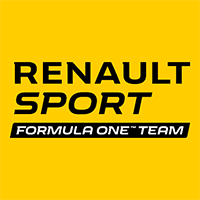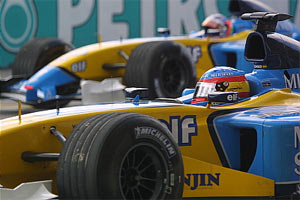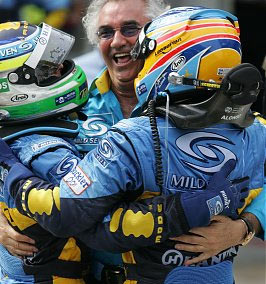Renault F1
 Based in: Viry-Chatillon, FR (engines) / Enstone, UK (chassis) Based in: Viry-Chatillon, FR (engines) / Enstone, UK (chassis)Founded: 1898 (active 1977-1985, 2001-2010, 2016-...) Website: http://www.renaultf1.com/ Team President: Bernard Dudot (1998-2003), Patrick Faure (2004-Mar 2006), Alain Dassas (Mar 2006-Sep 2007), Bernard Rey (Sep 2007-Dec 2011), Jean-Michel Jalinier (Jan 2012-Jun 2014), Jérôme Stoll (Jul 2014-2020) Managing Director: Flavio Briatore (1998-Sep 2009), Bob Bell (Sep 2009-Oct 2010), Eric Bouiller (Oct 2010-Sep 2014), Cyril Abiteboul (Sep 2014-2020) Chief Technical Officer: Bob Bell (Jan 2016-2020) Technical Director: Andre de Cortanze (1977-1978), Michel Tetu (1979-1984), Bernard Touret (1985), Mike Gascoyne (2001-2003), Bob Bell (Oct 2003-Sep 2009), Nick Chester (Jan 2016-2019), Pat Fry (Feb 2020-Dec 2020) Engineering Director: Pat Symonds (1998-Sep 2009) Technical Director Engine: Rob White (Apr 2005-...), Rémi Taffin (Jan 2016-2020) |
Renault began manufacturing racing cars back in 1899 and went on to win the first Grand Prix in 1906. After establishing itself as France's leading motor manufacturer a sporting division was created for sports car racing with the Alpine-Renault.
Many observers were surprised by Renault's decision to enter the Formula arena because of the risks involved in failure. Their choice of engine was also surprising. At the time of Renault's arrival on the scene the sport was run under the 3-litre formula. However an alternative of a 1.5 litre supercharged engine had never been removed from the rulebook and this was the option Renault took, based on their experiences with turbos from their sports car operation.
The first car, the Renault RS01, arrived for the 1977 British Grand Prix with Jean-Pierre Jabouille at the wheel. Success was limited mainly due the fact that much of the vast resources of Renault-Sport were devoted to winning the Le Mans 24 Hour race. Once that aim had been achieved, in 1978, attention switched to the Formula 1 project.
In 1979 the team fielded the Renault RS10 ground effect car at Monte Carlo and Jabouille scored an emotive first win at the French Grand Prix in Dijon, although the race is best remembered for the last lap battle between Gilles Villeneuve's Ferrari and the second Renault, driven by Rene Arnoux. The turbo engines proved dominant at the high altitude circuits where normally-aspirated cars struggled for breath. Arnoux won in South Africa and Brazil and that alerted the competition that all their futures would be turbocharged.
For 1981 Renault signed Alain Prost and he nearly clinched the title in his first season with the team. By 1982 the team was losing its advantage in turbo technology as BMW and Ferrari were closing the gap. Ferrari looked certain to take the title until Villeneuve was killed and Pironi seriously injured. Keke Rosberg eventually won the title for Williams despite one securing a single win all season. For 1983 Prost led the charge again and many expected the title to go to Renault. He was again pipped to the post after going out early from the South African race. Piquet took the title for Brabham. Prost blamed the team for falling behind on development and was given his marching orders. He moved to McLaren where, ironically, he was to enjoy the best years of his career.
1984 saw only limited success for Renault as all of the competition had finally cracked the art of turbo-driving. The team lasted for just one more year before withdrawing the works team to concentrate on supplying engines to Williams with whom they won five constructor's titles and four driver championships. 1998 sees the Renault name missing from the Formula 1 programme with subsidary Mechachrome providing the engines for Williams and Benetton (under the oddly named Playlife badge).
Buying into Benetton
 In 2001 full works support returned for the Benetton outfit, in advance of a complete rebranding for 2002. Renault then had its own Formula 1 team for the first time in seventeen years and, with several fourth places scored throughout the season, its potential was obvious. With the attraction of team manager Flavio Briatore who had won 2 championships with Benetton in 1994 and 1995, the team was ready for a new challenge. In 2002 the team also added Spanish driver Alonso to the list a promising people.
In 2001 full works support returned for the Benetton outfit, in advance of a complete rebranding for 2002. Renault then had its own Formula 1 team for the first time in seventeen years and, with several fourth places scored throughout the season, its potential was obvious. With the attraction of team manager Flavio Briatore who had won 2 championships with Benetton in 1994 and 1995, the team was ready for a new challenge. In 2002 the team also added Spanish driver Alonso to the list a promising people.
Where they were still fighting with backmarkers Minardi in 2001, the team steadily progressed during the following years. The team entered 2002 with Jenson Button and Jarno Trulli as regular drivers, while Alonso did the testing. Renault F1 also posessed the only 111° V10 engine of the field. The power plant proved revolutionary, yet problems with vibrations and stiffness caused it to be less reliable and powerful than normal 72° and 90° V10's.
 The team continued on their progress in 2003 with again an evolution of the previous car. Mike Gascoyne has led the team that once again improved the performance of Renault while Alonso pairing up with Trulli proved to be a successful driver duo. Alonso became the youngest driver ever to win a Formula One pole position at the 2003 Malaysian Grand Prix; he also became the youngest driver ever to win a Formula One race at the 2003 Hungarian Grand Prix. At season's end, he was a solid sixth in the championship, with 55 points and four podiums while Trulli grabbed 33 points and one podium.
The team continued on their progress in 2003 with again an evolution of the previous car. Mike Gascoyne has led the team that once again improved the performance of Renault while Alonso pairing up with Trulli proved to be a successful driver duo. Alonso became the youngest driver ever to win a Formula One pole position at the 2003 Malaysian Grand Prix; he also became the youngest driver ever to win a Formula One race at the 2003 Hungarian Grand Prix. At season's end, he was a solid sixth in the championship, with 55 points and four podiums while Trulli grabbed 33 points and one podium.
2004 saw the abandon of the 111° engine concept as the team designed a 72° V10. Immediately showing better power than the predecessor it allowed Jarno Trulli to take his first career win at Monaco 2004. The Italian however later fell in disgrace of Briatore because of several errors and letting go a podium place in the last last in Magny-Cours. He was replaced by Jacques Villeneuve for the last 3 races of that year. The 1997 champion could not prevent Renault to lose 2nd place in the constructor's championship.
As Renault had given up early on the development of their Renault R24, the team was completely ready for 2005. The engine had become on of the best of the field, Alonso more mature and Fisichella joined the team as his team-mate. Mike Gascoyne however went to Toyota and Bob Bell was assigned the new technical director. With Fernando Alonso and Giancarlo Fisichella driving for the team in 2005, the season started very well for Renault, as Fisichella won the Australian Grand Prix. Alonso then won five Grand Prix' to catapult himself and the team into the lead of their respective World Championships. The Alliance strolled on to win the Constructors and Drivers title in F1, making Alonso the youngest champion ever and Renault the most successful car maker in the world.
 The next year proved equally successful as the Renault R26 was again the car to beat. The team did however have a harder time. Part of that was caused with dubious decisions against the team, including the ban of the previously allowed mass damper, and a 5-place grid penalty for Alonso at Monza for alleged blocking of Ferrari's Massa during qualifying. During the race, the Renault mechanics even displayed their redesign of the FIA logo, now claiming "Ferrari International Assistance". Additionally, Michael Schumacher was desperate to end his career with a World Championship win, but saw that go up in smoke due to an engine failure at Suzuka. Renault again took both titles, effectively making it a "double double". Alonso then left the team on a high as he already signed for McLaren in December 2005.
The next year proved equally successful as the Renault R26 was again the car to beat. The team did however have a harder time. Part of that was caused with dubious decisions against the team, including the ban of the previously allowed mass damper, and a 5-place grid penalty for Alonso at Monza for alleged blocking of Ferrari's Massa during qualifying. During the race, the Renault mechanics even displayed their redesign of the FIA logo, now claiming "Ferrari International Assistance". Additionally, Michael Schumacher was desperate to end his career with a World Championship win, but saw that go up in smoke due to an engine failure at Suzuka. Renault again took both titles, effectively making it a "double double". Alonso then left the team on a high as he already signed for McLaren in December 2005.
Together with Alonso, long-time sponsor Mild Seven left the team because of tobacco regulations. After the signing of ING, the team was officially renamed ING Renault F1. It was meant to be a new era, but it turned out to be a less than successful one. Fisichella and Kovalainen struggled with the new Renault, mostly because the team's engineers had not found a definite solution to the switch of tyre suppliers. As Michelin left, Bridgestone was the only remaining supplier, but the Japanese tyres proved very different, especially the fronts were stiffer and posed problems. The team ended the season with 51 points and was third in the standings, after McLaren was removed from the standings due to a spy scandal triggered by Nigel Stepney.
Alonso's troubled year at McLaren pushed him back to Renault where he "always felt home". He teamed up with Nelson Piquet Jr. who was promoted from his test driver status in 2007.
While the year started off badly for the French team with a car that clearly lacked performance, gradually there was improvement, especially in the hands of Alonso. At his home Grand Prix at Barcelona, he ran in third place until the engine gave up. It wasn't however until the first night race at Singapore that they were back in the spotlights. Thanks to Piquet Jr. crashing out of the race on lap 12, Alonso could profit from the safety car to eventually win the race. One race later, the Spaniard repeated the same feat, although he beat everyone there on raw pace, rather than with "luck" involved.
2009 was to be Renault's step up to the front, but due to the massive regulation changes, they fell short - just like McLaren and Ferrari - on BrawnGP and Red Bull Racing. The team only really drew some attention when Flavio Briatore sacked Nelson Piquet Jr. after scoring zero points so far in 2009. He was replaced by Romain Grosjean as of the Belgian GP.
Three weeks later though, Briatore and Symonds were up in front of the WMSC after the FIA found out that Piquet Jr. crashed on purpose in Singapore 2008. Piquet Jr's statement eventually caused crash-gate, a scandal that saw Briatore and Symonds banned from Formula One. As Renault pulled their hands off of the people responsible, the team itself was handed a two-year provisional race ban.
Since that decision, Renault is thought to have been actively seeking to reduce its stake in the F1 team which it eventually did by selling 75% of the shares to GenII capital. Meanwhile, Robert Kubica was signed as the team's new lead driver after Fernando Alonso decided to move to Ferrari as of 2010.
By December, Eric Bouiller was announced as the new team principal. Later towards the start of the season, Vitaly Petrov signed as second driver, reportedly because of the marketing potential as a Russian driver.
Despite the winter uncertainties and even the hindsight of Kubica leaving due to the team's uncertain future, Renault brought a surprisingly good car on track. The Renault R30 allowed Kubica to fight for the podium at several tracks, mixing in between McLaren and Ferrari.
Later on in the year, Renault also announced the arrival of Daniele Casanova, joining the vehicle performance team after leaving Red Bull. That same week however, Bob Bell, after working his way up through Renault left the team, reportedly due to political issues within the team. Eric Bouiller took over his role at Managing Director, turning the team into Lotus F1 Team, albeit initially under the name Lotus Renault GP.
Saving Enstone
Having had trouble getting (enough) positive exposure via its engine supply to Red Bull Racing, Renault decided to return to Formula One as a factory team by means of taking over the Lotus F1 Team, essentially getting back where they left in 2010. Lotus at the time was on the verge of collapse, and a take-over was urgently needed to save the team from total collapse. This time around, Jérôme Stoll became president, with Frederic Vasseur appointed as team principal following a highly successful career in GP2. Cyril Abiteboul was promoted managing director already in September 2014 as part of Renault's early plans to investigate a full return to F1.

Given the financial issues, and hence lay-offs and lack of car development at Lotus in 2015, the R.S.16 was essentially nothing more than a minor development of the 2015 Lotus, and therefore hardly a successful competitor. Behind the scenes, things were arguably even worse, with the team seemingly unable to decide its driver line-up for 2016. It ended up in Kevin Magnussen opting to leave for Haas. Frédéric Vasseur left the team after having signed Nico Hulkenberg to join Jolyon Palmer for 2017.
It wasn't the end of the team's woes, however, as after finishing the 2018 season in 4th, reliability issues early on in 2019 and poor aerodynamic performance saw the team drop back down to 5th, failing to meet its aims to get closer to the field-leading Mercedes. At the end of the year, Chassis Technical Director Nick Chester left the team with former Ferrari and McLaren engineer Pat Fry joining and aerodynamicist Dirk de Beer returning to Enstone after some time at Williams and Ferrari.
2020 proved to be a lot better, especially after the team made a "set-up breakthrough" with their Renault Sport R.S.20 around the British Grand Prix after a number of difficult races. Progress was so obvious that there were rumours Daniel Ricciardo was starting to regret signing a deal with McLaren for 2021 following two years at the team.
Still, Renault opted to rebrand the team to Alpine F1 Team, the company's sports brand for the 2021 season.
Images by LAT/Renault F1Cars
| Car designation | Race years |
|---|---|
| Renault RS01 | 1977 - 1979 |
| Renault RS10 | 1979 |
| Renault RE20 | 1980 |
| Renault RE20B | 1981 |
| Renault RE30 | 1981 |
| Renault RE30B | 1982 |
| Renault RE30C | 1983 |
| Renault RE40 | 1983 |
| Renault RE50 | 1984 |
| Renault RE60 | 1985 |
| Renault RE60B | 1985 |
| Renault R202 | 2002 |
| Renault R23 | 2003 |
| Renault R23B | 2003 |
| Renault R24 | 2004 |
| Renault R24B | 2004 |
| Renault R25 | 2005 |
| Renault R26 | 2006 |
| Renault R27 | 2007 |
| Renault R28 | 2008 |
| Renault R29 | 2009 |
| Renault R30 | 2010 |
| Renault Sport R.S.16 | 2016 |
| Renault Sport R.S.17 | 2017 |
| Renault Sport R.S.18 | 2018 |
| Renault Sport R.S.19 | 2019 |
| Renault Sport R.S.20 | 2020 |
